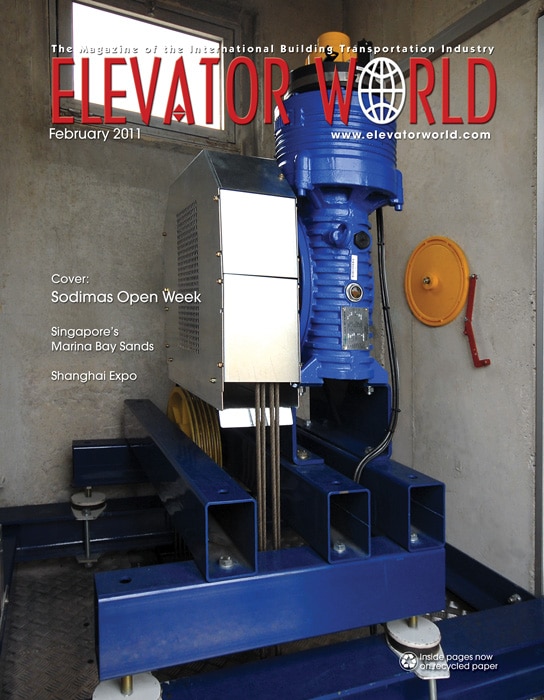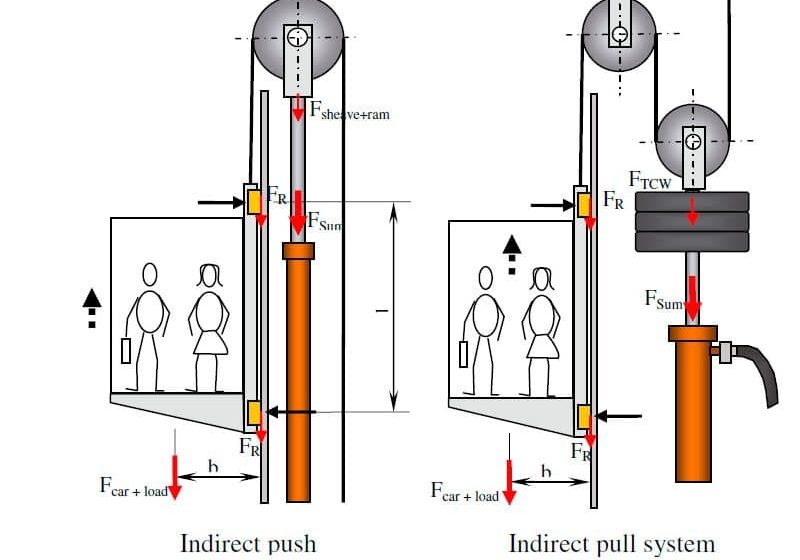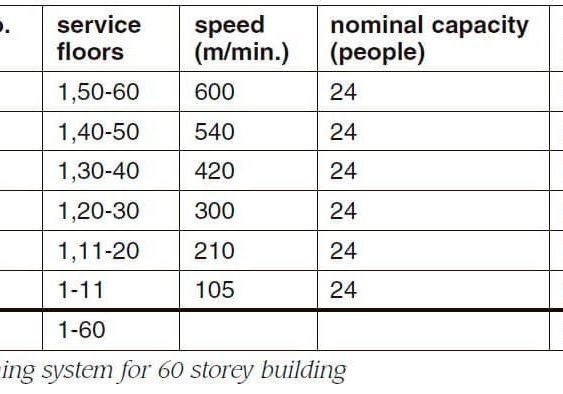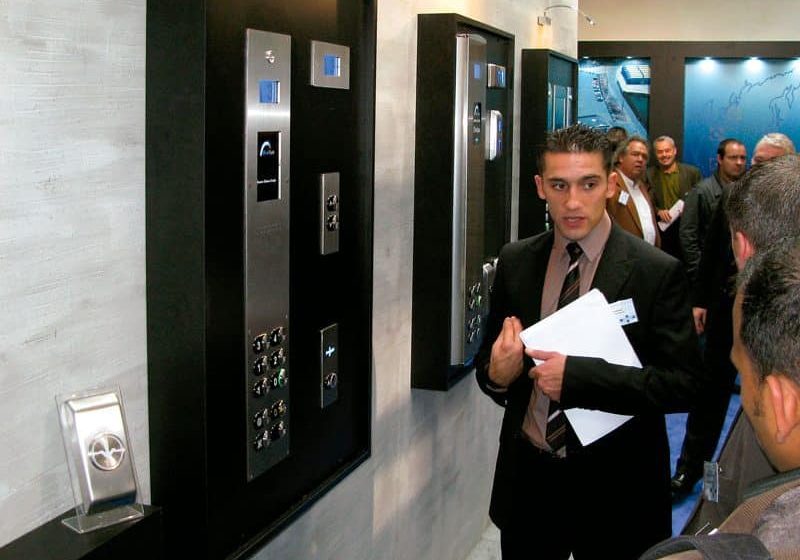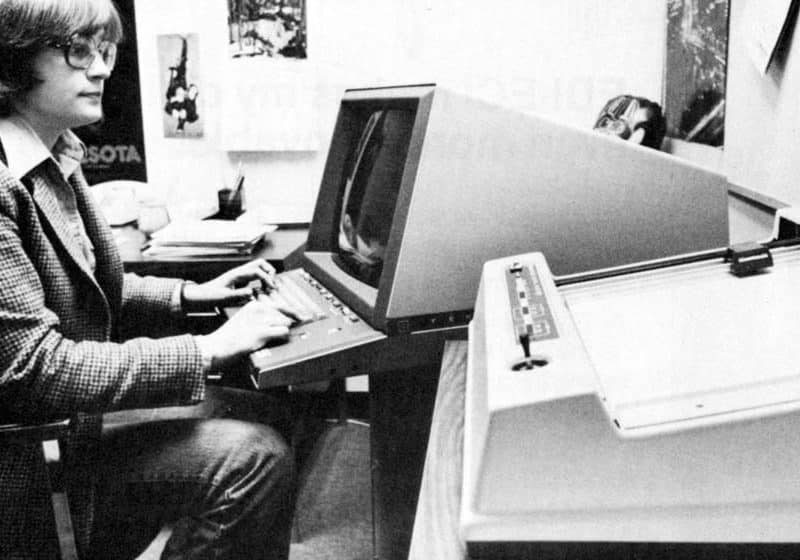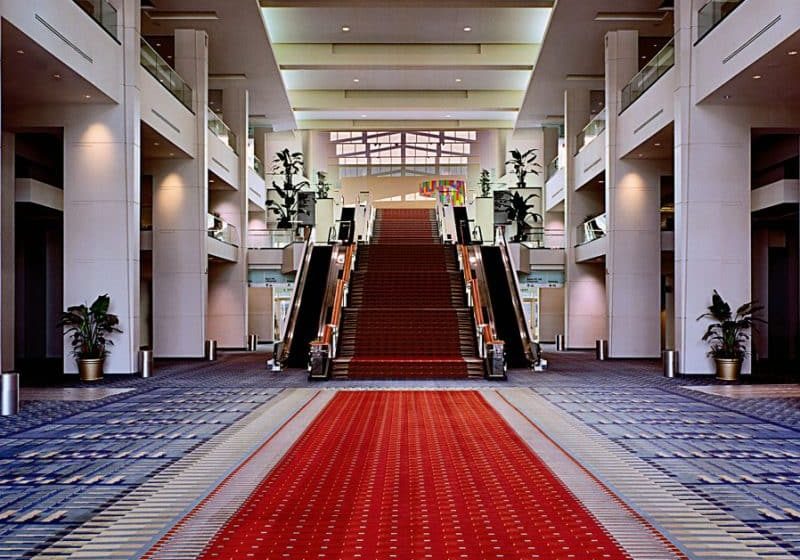Make a Better City: Expo 2010 Shanghai
Feb 1, 2011
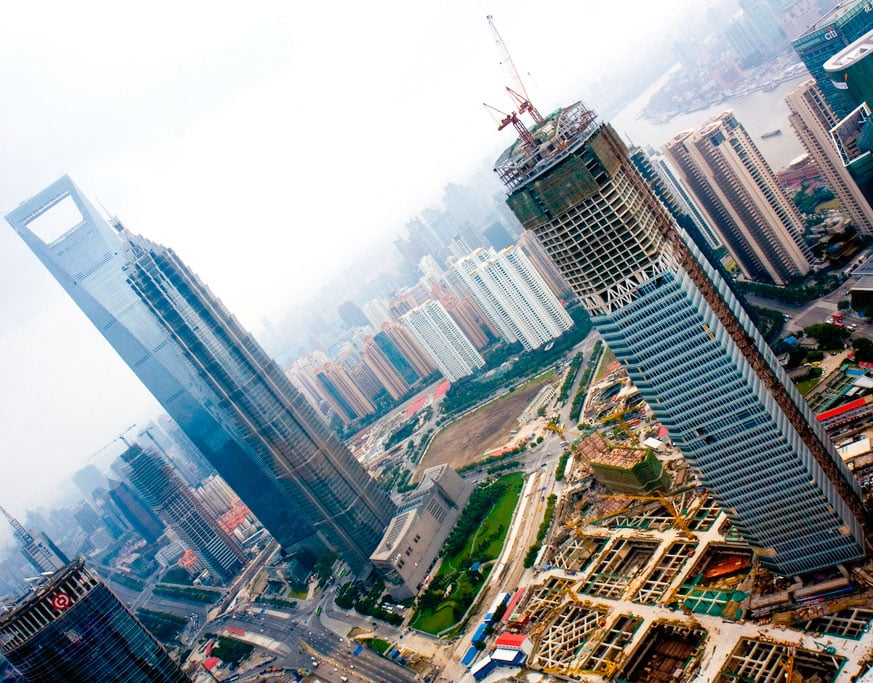
A look at the international expo, regarded as one of the best opportunities for elevator manufacturers to showcase their state-of-the-art vertical equipment.
by Peng Jie
My 2010 trip to Shanghai was to report on Expo 2010, which was open from May 1 through October 31. It was different from those I had made before. Metro Line 4, which started operation in September 2009, took me to Beijing South Railway Station after 500 m on foot from my home. From the metro station beneath the train plat-forms, a ride by escalator leads me up to Gate 12, where a train bound for Shanghai is awaiting passengers at the platform. Today, a trip to Shanghai by train takes roughly 10 hours, which will be reduced by half in two years when one of the world’s fastest shuttle trains (at the rated speed of 350 kph) goes into operation. (A test travel recorded the train at 416 kph in 2010.)
Life in the city is gradually changing as rail commuting systems are playing a more important role moving people around in metropolises such as Shanghai and Beijing. I’m surprised to see the great changes that had taken place in Shanghai since my last visit in November 2008. Today, Shanghai is providing both Chinese citizens and visitors from all over the world an urban metro network that may take one from a nearby metro station (within 800 m at any one point) to a destination such as the entrance to Expo 2010 Shanghai. The newly built Line 7 delivered your reporter directly from downtown Puxi, China, to Gate 6 of the Expo Park through a tunnel beneath the Huangpu River without notice.
A matrix of national flags in front of the southern end of the Expo Axis was a symbol of the internationality of the event. The Expo Axis consisted of six morning-glory-shaped, transparent paned columns standing in line along the main elevated walkway for pedestrians. At night, the paned morning glories presented an appealing sight by changing colors. National pavilions were built as name cards displaying participating countries’ history, natural, cultural and humanistic resources and responsibilities for global environment preservation, as well as economic development. The varied scale and style of the pavilions are also good showcases of exhibiting nations’ traditional and modern architecture.
Expo 2010 Shanghai is a global event under the Paris-based Bureau International des Expositions (International Exhibitions Bureau), with about 200 nations taking part. Its origins lie in the first International Exposition, held in London in 1851. The world elevator industry was not only born in coincidence with the age of the International Expo, but also provided all the vertical-transportation equipment needed to move hundreds of thousands of visitors up and down each day at the Shanghai event. The glorious beginning of our industry, marked with the announcement “It’s all safe” by Elisha G. Otis in 1853 laid a solid foundation for elevator and escalator builders across the world to create, develop, make and maintain vertical equipment for all types of buildings.
The International Expo has always been regarded as one of the best opportunities for elevator manufacturers to showcase their state-of-the-art vertical equipment. The five elevators installed in the Eiffel Tower for Expo 1899 (the Paris Universal Exhibition, as it was then called) provided safety and efficiency, especially with the double-car elevator that traveled daily with 75 passengers per trip for as long as 83 years. Throughout the event, hundreds of elevators and escalators could be seen working either indoors or in the open moving visitors throughout the Expo Park in defiance of the wind and rain in Shanghai.
The expo site was spread over a land area of 5.28 km2 by both sides of the Huangpu River between the Lupu and Nanpu Bridges to the southern end of the Bund. Although the event was defined as noncommercial in nature, it generated massive revenue for all parties involved, especially in populous China. There were 70 million visitors expected during the six months (184 days) of the event. On weekdays, paid entries varied from 200,000 to 400,000 each day (CNY160 [US$24] per person for a single entry), and on the weekend or public holidays, the number of daily visitors well surpassed 500,000 (and with higher entry prices) to fill in the organizer’s wise budget. With the unprecedented number of visitors, the franchised restaurants, souvenir shops, and food and drink vendors in the overcrowded Expo Park saw business booming every day.
Expo 2010 Shanghai is regarded as one of the greatest opportunities in a century for the Chinese people, especially those from the remote parts of the land, to see the world today. Though they could visit all the national pavilions they wished at the cost of time, money and hardship in traveling and waiting in the queues, some regrettably missed a few pavilions they desired to enter due to the exhaustive lines. Wait times to enter some pavilions, such as those of the Automobile, China, Germany, Japan, Saudi Arabia, Switzerland and the U.S., were often more than four hours. Hotel room rates were at least 50%higher than usual, and street vendors selling plastic folding stools could be seen.
Painted in Chinese red, the China Pavilion consisted of a dougong structure featuring a greater top built on a smaller base for the building. It was all based on four vertical cement tubes, 70 m apart from one another, forming the four corners of a square foundation, while four side beams lied horizontally on top. These measured as long as 140 m, to create a roof area of 19,600 m2 – sufficient for two-and-a-half World Cup soccer fields. An exhibit in the China Pavilion called “the model of the wood pavilion” from the Tang Dynasty unearthed in Xinjiang, China, could be considered the prototype of the 2010 China Pavilion. This exhibit dated back to more than 1,000 years ago. The dougong technology was widely applied to the upper structure in ancient Chinese architecture, which used to be instrumental to the building of giant palaces such as those in the Forbidden City, pavilions and multi-storied pagodas. In dougong, tiers of brackets are inserted between the top of a pillar and a crossbeam; each bracket is formed from a bow-shaped arc called gong, which is cushioned with a block of wood called dou.
World expos have served as galleries of human inspirations and innovations. Since 1851, these events have attained increasing prominence as a series of grand events for economic, scientific, technological and cultural exchanges, providing a global forum for countries to exchange historical experience and innovative ideas, and display their diversified natural resources, histories and cultures, along with national achievements in varied fields.
With the theme of “Better city, better life,” Expo 2010 Shanghai focused on the urban life in the 21st century, showcasing creative solutions to the common ecological problems all nations have to face and urban cultures evolved from diversified tradition. The prospect of future urban life is a subject of global interest. In 2010, roughly 55% of the world population lived in cities (according to estimation by the United Nations). The trend of global urbanization is in acceleration, which concerns everyone in any country – big or small, developed or developing. Housing, urban traffic, education, power supply, a deteriorating environment and increasing carbon emission are among the challenges all people on Earth face.
Shanghai is a metropolitan city with some of the high-est numbers of elevators and escalators in the world. The International Financial Center (EW, October 2010) (492 m high with 101 floors) dwarfed the nearby Jinmao Tower (EW, February 2001) in 2007. However, Shanghai Tower (632 m high with 127 floors) is now under construction and will surpass both in height by 2013. The structure of the new skyscraper alone is 580 m tall. The edifice is to stand up in tripod with Jinmao Tower and the International Financial Center in the heart of Lujiazui Central Business District in Pudong.
In some urban areas of Shanghai, residential towers with more than 30 floors stand close to one another like tall trees in the woods. Elevators and escalators are indispensable for vertical traffic to everyone in the city. The vertical equipment serves as part of the short-range transportation systems of daily life, offering necessary convenience to pedestrians and residents. Elevators and escalators are not only installed in buildings, but also seen on the street. In an age when energy saving and low carbon emission trips such as metro commuting and bicycle riding are advocated, the elevator industry plays an ever-increasing role in improving life quality (measured by waiting time and riding comfort) of city inhabitants. In addition, there is the potential for our industry to further reduce the building space an elevator needs for installation and the energy consumption by existing solutions such as machine-room-less, destination-selection-control and energy-retrieving technologies.
Equipped with brand-new elevator and escalator installations, the hustle and bustle of the Shiliupu riverfront port is no longer there, because today, few would travel by ship to Shanghai from Chongqing or Wuhan by the waterway of the Yangtze (which used to take around five and three days, respectively). Modern technology has provided for much faster vehicles such as airliners and shuttle trains for long-distance travel. However, passengers have to depend on cars, buses and metro systems for trips to move from place to place in a city, and elevators and escalators to ride from floor to floor in a building efficiently and comfortably. In this age, elevators greatly contribute to a better city.
Newly built skyscrapers are often using underground spaces for pedestrian convenience. Shanghai Tower will be connected directly to a metro station and its neigh -boring buildings beneath. Passenger transportation is an important part of daily life, no matter the length of the journey. The elevator industry is ready to provide solutions for such terminals as airports and metro stations with well-tailored elevators, escalators and moving walks. The latter have found wide applications in a number of airports worldwide, and the potential demand for these in metro stations and underground passages appears great.
The construction of Shanghai Tower features an asymmetrical spiral tower outlook that will use as many local materials as possible. Its vertical-transportation equipment is no different and will save resources within a budget of CNY15 billion (US$2.24 billion). With skyscrapers such as the Shanghai Tower under construction, the skyline of Shanghai keeps changing, and so do the streets. With the planning of Expo Park, a lot of aged residential buildings near the Shiliupu Port gave way to modern urban facilities, including a newly built passenger transportation terminal directly connected with the riverfront port and the green Gu Cheng (Ancient Town) Park.
In dealing with the heavy population of skyscrapers, city dwellers need sufficient green parks close to home for better city life. However, this presents a challenge to city administrators, as they have to tear out a piece of precious land from which skyscrapers could rise for immediate benefit. Innovative and creative ideas are key to such problems. The expo is a great forum for countries to learn experience and expertise from each other in dealing with such issues as sustainable development. The convenience of the facilities Shanghai prepared for the expo will be greatly appreciated, and all look forward to seeing a better Shanghai in the future – more green parks for city inhabitants, closer metro stations for pedestrians and more moving walks for passengers in interchange metro stations. Every people-friendly detail in the urban infrastructure contributes to a better life in the city.
Almost every exhibiting country expressed the commitment to sustainable development. With a responsible ecological conservation and an environmentally conscious outlook, many countries are beginning to take disciplined sustainable develop-ment approaches, which are good for both economy and ecology. The utility of solar and wind energy is among preferred solutions in place of using oil as fuel. For instance, Shanghai Tower is to install 54 wind-powered generators on it for an annual output of 540,000 kW. In the Expo Park, environmentally friendly buses move visitors from place to place. These electric vehicles do not use any oil-based fuel; they get their driving batteries charged from a pair of overhead cables when stopped. Bicycles remain a favorable means for short-range trips in cities, as this can be seen in the Netherlands and Denmark in the same fashion.
One of the most impressive buildings on the expo site is the Culture Center by the Huangpu River. Its look is that of a flat seashell or space shuttle. The design modernly merges Chinese and Western architectural elements in trend with a number of prestigious designers across the world taking part in the bidding. These include KPF of the U.S.; GMP of Germany and East China Architecture Design Institute (ECADI) of China. Each bidder presented a number of outstanding designs, and the final work is actually a combination of the best architectural concepts and creativeness from each party based on the ECADI design. It is a multifunctional building mainly for recreation and sports, with 18,000 seats in the main hall. The whole area can be divided into several smaller independent halls by means of separating walls for different performances or shows taking place simultaneously. These hold 4,000, 5,000, 8,000, 10,000 or 12,000 audience members, respectively, depending on the needs. Your reporter saw shops and restaurants open for business that could hold as many as 1,000 people each.
The construction of the Culture Center took 27 months until completion, which was on March 30, 2010. This building is one of four permanent structures to remain on site after the expo. Escalators and elevators within it are designed for varied vertical traffic modes, with flexible handling capacity. The building managers can have two escalators running side by side for incoming visitors, and those leaving in small groups take the lifts down. It would be a treat to ascend the upper floor by escalator for a stroll around the open circular observation deck overlooking the Huangpu River. One could command a wonderful view of the old and new landmark buildings of Shanghai on both banks of the shimmering river decorated with ships and bridges.
Get more of Elevator World. Sign up for our free e-newsletter.

